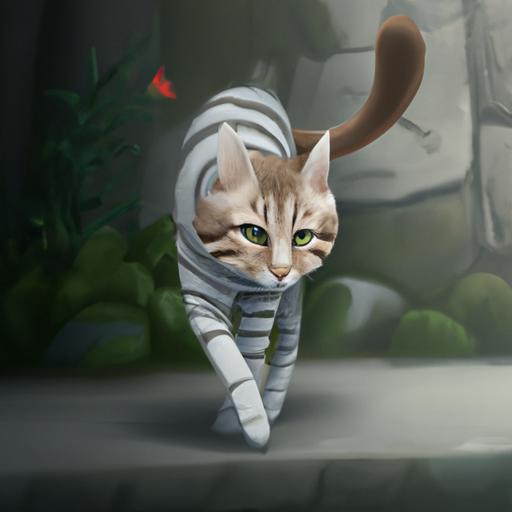Are cats and tigers related? On the surface, the answer may seem obvious.
But if you take a deeper dive, you may be surprised to learn that there is more to cats and tigers than the average person realizes.
In this article, we’ll take a look at the taxonomical relationship between cats and tigers, explore their physical and behavioral differences, and discover how they have adapted over time.
We’ll also take a look at the fascinating human-cat relationship, and explore how cats have become a part of our modern lives.
So if you want to learn more about the subtle, yet fascinating relationship between cats and tigers, read on!.
Table of Contents
Are Cats And Tigers Related?
Yes, cats and tigers are related.
They are both members of the Felidae family and share the same ancestor, the Proailurus.
Cats and tigers are both predatory carnivores, but cats are much smaller than tigers.
Taxonomy of Cats and Tigers
Cats and tigers may both be part of the cat family, but the two species have evolved differently to live in different environments with different lifestyles.
Cats are members of the Felidae family, which includes small to medium-sized carnivores such as lions, tigers, leopards, and jaguars.
On the other hand, tigers are members of the Panthera genus, which also includes lions, leopards, and jaguars.
This difference in taxonomic classification is important in understanding the behaviors and adaptations of each species.
Both cats and tigers are classified as carnivores and possess retractable claws that allow them to capture and hold their prey.
However, cats have adapted to live in close proximity with humans, whereas tigers have evolved to be large and powerful creatures that live successfully in the wild.
Domestic cats, for example, have shorter legs and softer fur than their wild counterparts and have become dependent on humans for food, shelter, and companionship.
In contrast, tigers are the largest members of the Panthera genus and are well-known for their strength and predatory skills.
Their fur is thicker than that of cats and their legs are longer and more powerful, allowing them to hunt and run long distances.
They have evolved to be solitary hunters in the wild, stalking their prey silently and with great stealth.
Cats and tigers have evolved differently to survive in different environments, but they still share a common ancestor.
Understanding the taxonomic differences between cats and tigers can help us appreciate the unique traits of each species and the adaptations they have developed to survive in the world around them.
Physical Differences Between Cats and Tigers

Though cats and tigers may seem like similar creatures, they are actually quite different in many ways.
From their size, to their physical features, to their habits, cats and tigers vary greatly.
To begin, cats are much smaller in size than tigers.
On average, cats range from 2-9 kg while tigers can range from 90-300 kg.
Cats have short legs and flexible bodies, while tigers have long legs and powerful bodies.
Cats also have slender faces and rounded ears, while tigers have wide faces and pointed ears.
Additionally, cats have short, smooth fur while tigers have thick, coarse fur with stripes.
Cats have retractable claws while tigers have non-retractable claws.
Cats are usually nocturnal while tigers are usually diurnal.
Cats are typically between 5-15 pounds, while tigers can weigh up to 660 pounds.
Moreover, cats have slender bodies and short legs, while tigers have much thicker and muscular bodies with longer legs.
Cats have small heads relative to their bodies, while tigers have much larger heads.
Cats have smaller, pointed ears, while tigers have much larger, round ears.
Cats have short tails, while tigers have long, powerful tails.
Cats have short fur, while tigers have thick, long fur.
Cats have retractable claws, while tigers have slightly longer and more powerful retractable claws.
Cats have round pupils, while tigers have slit pupils.
Finally, cats have a sharp sense of smell and hearing, while tigers have an even stronger sense of smell and hearing.
As you can see, cats and tigers may seem alike, but they have many differences that distinguish them.
From their size, to their physical features, to their habits, cats and tigers vary greatly.
Behavioral Differences Between Cats and Tigers
Cats and tigers may both be part of the feline family, but they have some distinct differences when it comes to behavior and lifestyle.
Cats are domesticated animals that are typically very comfortable around humans, while tigers are wild animals that are not typically comfortable around humans.
Cats are typically content with living in small spaces, while tigers need larger areas to roam and hunt.
Cats can be trained to do certain behaviors and tricks, while tigers are not typically trainable.
Cats are solitary animals, while tigers live in larger groups called prides.
Cats are very vocal, using meows and purrs to express their feelings, while tigers are not typically vocal animals.
Cats are content with living indoors and do not need to hunt for food, while tigers need to hunt for their food.
Cats also use their claws for different activities than tigers.
Cats use their claws for climbing, grooming, and playing, while tigers use their claws for hunting and defense.
Cats are known to be docile and friendly, while tigers are more independent and solitary.
Cats are often domesticated and kept as pets, while tigers are wild animals that are rarely kept in captivity.
Cats are usually comfortable around humans, while tigers are typically wary of them.
Cats are usually more playful and active during the day, while tigers can be active during the day or night.
Cats have been known to form close bonds with their owners, while tigers usually do not.
Cats have been known to show affection by purring, while tigers usually dont.
Cats may sometimes hunt small animals, while tigers are more likely to hunt larger prey.
Overall, cats and tigers may be part of the same species, but they have some very distinct differences in their behavior and lifestyle.
Cats are domesticated and comfortable around humans, while tigers are wild and not typically comfortable around humans.
Understanding these differences can help us appreciate the unique traits of cats and tigers and how they fit into our lives and the world around us.
How Cats and Tigers Have Adapted Over Time

Cats and tigers are two of the most iconic animals in the world.
While they both belong to the same species, Felidae, they have evolved in drastically different ways over time.
Cats have become smaller and more domesticated, while tigers have become larger and more powerful.
Cats have developed a number of skills that make them well-suited to living with humans, such as their ability to learn quickly, their strong instinct for self-preservation, and their social nature.
They have also evolved to become physically smaller over time, allowing them to better adapt to living in close proximity to humans.
Cats have also developed retractable claws, which helps them to better capture and hold onto prey.
They have adapted to living in a wide variety of environments, such as in homes, farms, and jungles.
Cats have developed a more efficient digestive system, allowing them to process food faster.
Tigers, on the other hand, have become larger and more powerful creatures.
They possess powerful jaws, large paws, and sharp claws, which make them well-suited for living in the wild.
Tigers have also developed a keen sense of smell, which helps them to find prey in the wild.
With the help of their strong sense of smell, tigers have become proficient hunters, able to take down large prey with ease.
Tigers have adapted to living in a variety of wild habitats such as forests, grasslands, and swamps.
They have also evolved to have a slower digestive system, allowing them to digest larger amounts of food over a longer period of time.
Tigers have become more solitary creatures, and unlike cats, do not have any vocalizations.
Over time, cats and tigers have evolved to become successful species in their own right.
Cats have adapted to living in close proximity to humans, while tigers have become more adapted to living in the wild.
Both species have adapted to their different environments and have developed skills that help them to survive.
Cats and tigers are both remarkable animals that have evolved in fascinating ways.
The Human-Cat Relationship
For thousands of years, cats have been kept as beloved pets by humans across the globe.
Ancient Egyptians were among the first civilizations to recognize cats as symbols of good luck and fertility.
Since then, cats have become a popular pet, with studies showing that cats not only form strong bonds with their owners, but can also provide companionship, help reduce stress, and even keep pests away from the home.
Cats have been domesticated by humans for many centuries, and their natural affinity for humans has led to strong emotional bonds between them and their owners.
Often seen as independent creatures, cats are actually very social animals, and have adapted to living close to humans by becoming more vocal, playful, and social.
Cats have even been known to help humans with daily tasks such as hunting, herding, and pest control.
It is clear that cats have been a significant part of mankind’s history, and their presence in our lives has been beneficial to us in many ways.
From providing companionship and comfort to helping with daily tasks, cats have become an integral part of our lives, and it is no wonder that they remain such popular pets today.
Final Thoughts
It’s amazing how two animals that look so similar can actually be so different.
Cats and tigers may look and behave similarly, but their taxonomy and anatomy have evolved differently over time.
Cats have adapted to living in close proximity to humans, while tigers have become powerful creatures that live successfully in the wild.
We can learn a lot from studying the relationship between cats and tigers, and the ways in which they have adapted over time.
So next time you snuggle up with your furry friend, take a moment to appreciate their unique history and the evolutionary journey they’ve taken.

